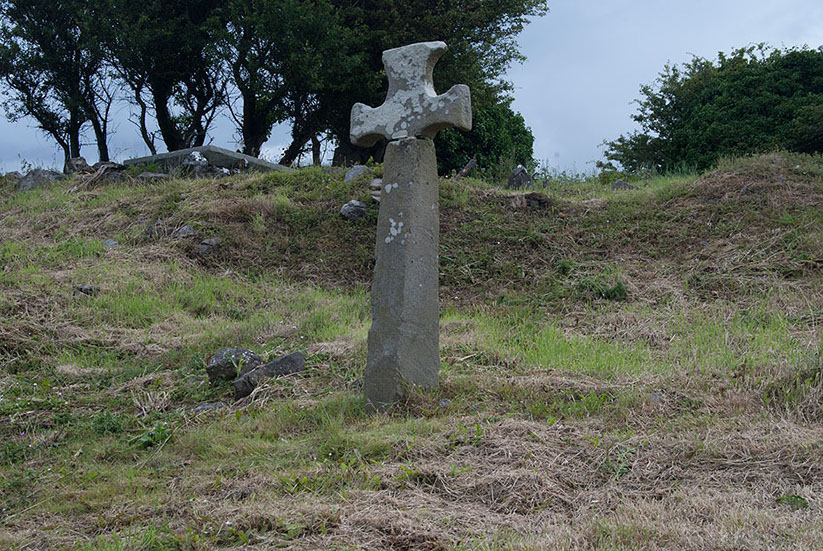Crosspatrick/ “Crospatrai” Cemetery
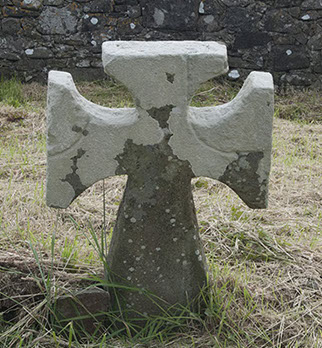
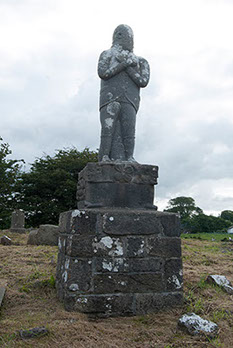
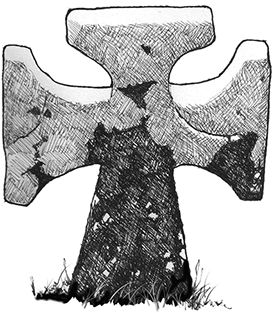
When entering or exiting the town of Killala by the Ballina road, about one and a half kilometres from the outskirts of the town, the traveller will pass close by the ancient cemetery of Crosspatrick.
As is known, St. Patrick had strong, well-documented connections with Killala and its environs (Killala may have been the port from which he escaped Ireland as a youth), and as a result, many places are named for him, including Crosspatrick, the reputed site of one of his encounters with the Celtic druids.
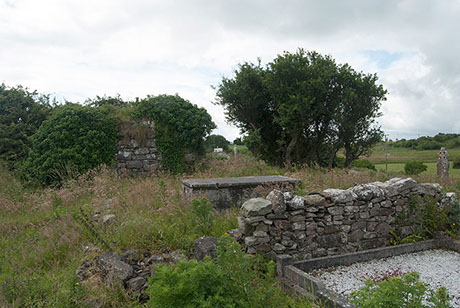 The ecclesiastical chroniclers of old inform us that upon his return to this district, St. Patrick had a hostile encounter with the local Druids and it was only after much charged negotiating that he eventually overcame the efforts of these Celtic priests, and brought his tussle with them to a victorious, if rather fantastic conclusion. Following this encounter, Patrick impressed upon the earth a cruciform sign, and from this spot sprung a well, and close by he built a church.
The ecclesiastical chroniclers of old inform us that upon his return to this district, St. Patrick had a hostile encounter with the local Druids and it was only after much charged negotiating that he eventually overcame the efforts of these Celtic priests, and brought his tussle with them to a victorious, if rather fantastic conclusion. Following this encounter, Patrick impressed upon the earth a cruciform sign, and from this spot sprung a well, and close by he built a church.
In the cemetery grounds the ruins of an ancient oratory (possibly 7th or 8th century), the successor of the original, may be viewed. Built with local limestone and mortar, the church measures 26’ long by 15’ wide (inside), and even though the gables have collapsed, a sizeable portion of the side-walls still remain. Local lore maintains that stones from the church may have been used to build a burial enclosure along the north side-wall.
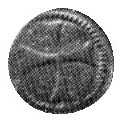 Close by the church ruins there are two time-worn gravestone carved in the manner of a Cross-Pattée, a motif which once had a Druidic link, as in the Sacred Landscape logo, but since the fifth century is associated with St. Patrick. In fact, in 1461, copper-half farthing was issued which bore the head of St. Patrick on the obverse and a Cross-Pattée on the reverse. Many believe that this is one of the earliest examples of a commemorative coin issued and as 461 is the date referenced as being the year of Patrick’s death, the coin may have been issued to commemorate the one thousandth anniversary.
Close by the church ruins there are two time-worn gravestone carved in the manner of a Cross-Pattée, a motif which once had a Druidic link, as in the Sacred Landscape logo, but since the fifth century is associated with St. Patrick. In fact, in 1461, copper-half farthing was issued which bore the head of St. Patrick on the obverse and a Cross-Pattée on the reverse. Many believe that this is one of the earliest examples of a commemorative coin issued and as 461 is the date referenced as being the year of Patrick’s death, the coin may have been issued to commemorate the one thousandth anniversary.
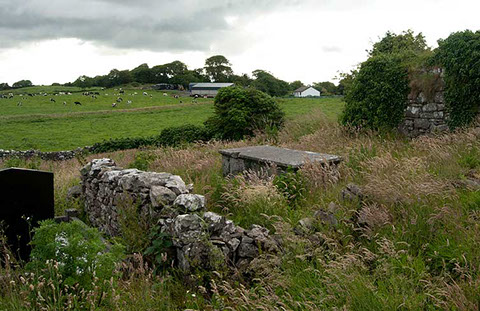 The red saltire later superseded the Cross-Pattée as the official ‘St. Patrick’s Cross’ and as such, after the passing of the Act of Union in 1800, it was incorporated into the British Flag-the ‘Union Jack.’ Since the Union, the saltire of St. Patrick has been incorporated in a wide range of flags, including the flags of the Commission of Irish Lights, the Royal Dublin Society, the Irish Rugby Football Union, the Royal College of Surgeons in Ireland and the Freemasons. It is also used on St. Patrick’s Day in Northern Ireland as a neutral symbol and it is centrally incorporated into the badge of the Police Service of Northern Ireland.
The red saltire later superseded the Cross-Pattée as the official ‘St. Patrick’s Cross’ and as such, after the passing of the Act of Union in 1800, it was incorporated into the British Flag-the ‘Union Jack.’ Since the Union, the saltire of St. Patrick has been incorporated in a wide range of flags, including the flags of the Commission of Irish Lights, the Royal Dublin Society, the Irish Rugby Football Union, the Royal College of Surgeons in Ireland and the Freemasons. It is also used on St. Patrick’s Day in Northern Ireland as a neutral symbol and it is centrally incorporated into the badge of the Police Service of Northern Ireland.
On the opposite side of the main road, about 100 metres in the direction of Killala and 20 metres in off the road, hidden in briars and undergrowth the aforementioned ‘Holy Well’ (St Patrick’s Well) still flows. This spring was once venerated by local people and is probably the well mentioned in Chapter 81 of the Vita Tripartita Sancti Patricii-The Tripartite Life of Saint Patrick which tells that close by a spring St. Patrick restored a man’s sight. The location is given as “near the church called CrossPatrai.” It is mentioned again in Chapter 83 as being the scene of another miraculous cure:-“...The holy man restored to him according to his expectation and the merit of his faith, the office of his feet and the power of walking, at (juxta) (or near), the aforesaid fountain, which lies adjacent to the Church of Cros-Phadruic to the West”.
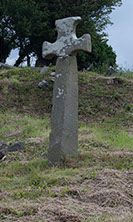 It is believed that it was here at Crosspatrick that St. Patrick may well have met with twelve sons of King Amhalghlaidh-‘Awley,’ the then King of Connacht, who despite being an old man of very advanced years at the time, still ruled the prosperous and fertile Province. The King had a very large family, eight sons by one wife and seven by another, although some of his children may well have been dead by this time. Nonetheless, the existing King’s children were in dispute with each other and the chief cause of this strife was who should succeed their father as King of Connacht, or at least King of Tirawley. It is told that St. Patrick travelled to Tara with the sons and in collaboration with their cousin Laoighaire, the then High-King of Ireland, presided over the dispute. The names of the twelve sons who met with St. Patrick were: Onegus, Fergus, Fedilimid, Enda Crom, Enda Cullomm, Cormac, Coirpre, Echaid Oenau, Enclaid Diainim, Eoghan Coir, Dubchonall, and Aill “Kettleface.”
It is believed that it was here at Crosspatrick that St. Patrick may well have met with twelve sons of King Amhalghlaidh-‘Awley,’ the then King of Connacht, who despite being an old man of very advanced years at the time, still ruled the prosperous and fertile Province. The King had a very large family, eight sons by one wife and seven by another, although some of his children may well have been dead by this time. Nonetheless, the existing King’s children were in dispute with each other and the chief cause of this strife was who should succeed their father as King of Connacht, or at least King of Tirawley. It is told that St. Patrick travelled to Tara with the sons and in collaboration with their cousin Laoighaire, the then High-King of Ireland, presided over the dispute. The names of the twelve sons who met with St. Patrick were: Onegus, Fergus, Fedilimid, Enda Crom, Enda Cullomm, Cormac, Coirpre, Echaid Oenau, Enclaid Diainim, Eoghan Coir, Dubchonall, and Aill “Kettleface.”
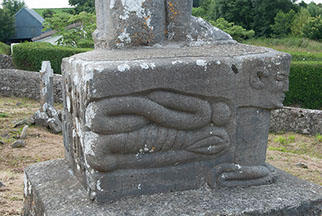
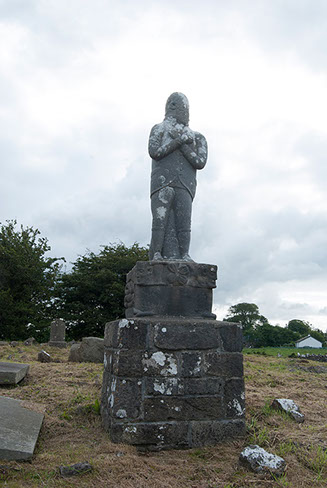 Crosspatrick cemetery is noticeable today as it boasts a curiously strange statue of a man. The sculpted figure, bearing the date 1881, was carved by a former Crosspatrick resident, Thomas Mulloy, a celebrated craftsman and artificer of his day, and now stands over his grave. The face, now damaged, is turned to the left, in the direction of the parish of Cooneal, Mulloy’s birthplace, and also the direction of his former licensed premises which was known as ‘the Half-Way House,’ as it was equidistant between Killala and Ballina. He is dressed in knee-britches and buckled shoes and his arms are folded across his chest as if in death. His coat shows four buttons and two pockets with the bottom button of his waistcoat left undone. It is told in the local tradition that Mulloy left five shillings in his will to be given to anyone who was able to close the undone button.
Crosspatrick cemetery is noticeable today as it boasts a curiously strange statue of a man. The sculpted figure, bearing the date 1881, was carved by a former Crosspatrick resident, Thomas Mulloy, a celebrated craftsman and artificer of his day, and now stands over his grave. The face, now damaged, is turned to the left, in the direction of the parish of Cooneal, Mulloy’s birthplace, and also the direction of his former licensed premises which was known as ‘the Half-Way House,’ as it was equidistant between Killala and Ballina. He is dressed in knee-britches and buckled shoes and his arms are folded across his chest as if in death. His coat shows four buttons and two pockets with the bottom button of his waistcoat left undone. It is told in the local tradition that Mulloy left five shillings in his will to be given to anyone who was able to close the undone button.
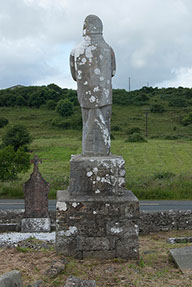 A short dedication on the back of the statue reads in raised letters “T. Mulloy+1880”, while the front base boasts a four-leaved shamrock, two heads, and an angel with hands joined on one side and a coiled serpent on the other. It is maintained that Mulloy carved the statue in his workshop which once stood close to the aforementioned “Half-way-House,” but that it was damaged by local youths throwing stones at it, for which he was awarded £20 in a malicious injury claim. The repaired statue was erected after his death, but in 1926, during a severe storm, it was blown down face-first, hence the damage. In 1929, Canon Greany of Killala had the statue re-erected by a Mr. Bermingham, a contractor whose firm was at the time building Killala School.
A short dedication on the back of the statue reads in raised letters “T. Mulloy+1880”, while the front base boasts a four-leaved shamrock, two heads, and an angel with hands joined on one side and a coiled serpent on the other. It is maintained that Mulloy carved the statue in his workshop which once stood close to the aforementioned “Half-way-House,” but that it was damaged by local youths throwing stones at it, for which he was awarded £20 in a malicious injury claim. The repaired statue was erected after his death, but in 1926, during a severe storm, it was blown down face-first, hence the damage. In 1929, Canon Greany of Killala had the statue re-erected by a Mr. Bermingham, a contractor whose firm was at the time building Killala School.
In 1851, Mulloy was selected to represent the province of Connacht at the Great Exhibition which was held at the Crystal Palace, London, and his exhibit, a superbly carved chair, was described as being “remarkable.” Some sources claim that it was later presented to Queen Victoria as a gift. Afterwards, a rumour, probably created by himself, arose in the locality which stated that Victoria was so taken with the chair that she decreed Mulloy should be allowed to run his Public House from thenceforth with a “Free Licence”-in other words, that he could run the pub without having to pay any tax!
The following piece titled “Curious Chair For The Great Exhibition of 1851” which is gleaned from The Tyrawley Herald, January, 1850, vividly describes the exhibit.
“On yesterday we had the pleasure of viewing a very remarkable chair, made by a person in this neighbourhood, and which reflects vast credit on his ingenuity in its contrivance, and on his skill in the execution of the work. The seat of the chair is of sycamore, beautifully inlaid with black oak in imitation of birds perched on a tree. The front has two snakes very accurately delineated, under the seat. The legs are in the form of a serpent, coiled in with the front rail. Each side of the chair has two arms. The lower one is simply coiled. The upper one represents a human arm, and as a medical gentleman who was present suggested, having the biceps muscle beautifully developed. The hands, fingers, and nails, are also accurately carved. At the back of the chair, beginning near the seat, there are two dolphins, whose tails elegantly interwoven with the sides of the chair serve to cement the whole together. The heads of the two fish, meeting together support the Irish Harp, which is surmounted with the shamrock and crown, all elegantly and elaborately carved. The entire work is of the most tasteful character, and well deserves a place in the approaching exhibition of the industry of all nations. It has completed in the space of four months, and was executed by Mr. Thomas Molloy who resides between this town and Killala. He is to use his own expression, “a wide and self-taught man.” The chair is, at any rate, a remarkable specimen of ingenuity and labour. We trust that, at the exhibition it will meet with that reception which will reward the maker for his skill, and for his enterprise in bringing it forward there. This will be, we believe, the only specimen from this quarter, which is to have a place in the Crystal Palace.”
Saint Patrick and Killala
It is generally believed that about the year 401 A.D., the Ard-Rí or High King, ‘Niall of the Nine Hostages’ raided the coast of Britain carrying of many prisoners. The epithet ‘Of the Nine Hostages’ was applied to Niall because of the number of hostages and payments he extracted from the princes conquered by him; in addition to hostages, he also brought from his many expeditions to Britain and Armorica (present-day Brittany), several hundred captives. Among those taken was a ten-year youth called ‘Succat’-for that was Patrick’s original name.
While many authorities assign Dumbarton in Scotland as his birthplace, the majority regard Patrick as having been a native of a small town which was then situated close to the estuary of the River Severn, on the Welsh side, a town known as Bannaven Taberniae. It is believed that Patrick was of the minor nobility class and consequently would have had a privileged background; Calpurnius, his father, was employed by the Romans as a deacon and tax collector, while his mother, Concessa, is reputed to have been a sister of the man who would later be canonised as Saint Martin of Tours.
According to the tradition of Killala and North Mayo, after six years in bondage, spent mostly as a swineherd/shepherd in county Antrim, where he toiled for an exacting master, a petty chieftain named Milchu, the youthful Patrick, guided by a dream, made his way cross country to the Wood of Focluth/Silva Focluti (present-day Foghill close by Killala) where he was given shelter by a man named Gleru. The tradition further maintains that Patrick escaped from either Killala, or Kilcummin, where there is still a spot pointed out as ‘Patrick’s Rocks, ‘ and made his way home by merchant ship, before heading for Nantes in Gaul (France).
Having studied for a number of years at both Nantes and Tours, Patrick, now a noted linguist, journeyed to a monastery on the island of Lerins, near Cannes, where he remained for a further three years (412-415) before returning to his own people in Wales. Back with his own, Patrick dreamed frequently and often heard “the voice of those who were in the Wood of Foclut, which is near the Western Sea” calling to him to return amongst them. Regarding these dreams as inspired, Patrick determined to return to Ireland. In preparation for his work he went to Auxere where he studied theology under the man who would become Saint Germain, and in due course was ordained a priest. He remained in Auxere until 432, when at the age of 42, Pope Celestine sent him to Ireland to carry on the work of his predecessor, Palladius, “as Bishop to undertake the conversion of the Irish people and to organize the Church in Ireland.”
Some associations with Saint Patrick
Down Patrick Head (close by Céide Fields) contains ruins of a church dedicated to Patrick and also has a huge tradition of the battles between the Pagan Crom Dubh and Patrick.
Kilcummin and the Garland Sunday tradition also associated with Patrick and Crom Dubh.
St Patrick’s Rocks, Kilcummin, from where tradition maintains he escaped Ireland.
Foghill is the place mentioned in Patrick’s writings as the place where the people of the Western Sea came to him in his dreams. It is traditionally believed that Patrick crossed the country and was given sanctuary in Foghill after escaping captivity in Ulster.
St Patrick’s Well, Foghill, where Patrick reputedly baptized 900 converts and raised to life and baptized a woman who had earlier died-it was also his place of sanctuary.
Killala-described as “St. Patrick’s City” by Giolla McFirbisgh.
St Patrick’s Bartrach-Bartra Island off Killala.
St Patrick’s Cathedral Killala, this maybe the site where Patrick baptized the two maidens Crebriu and Lesru, the daughters of Gleru, who had once given him sanctuary in Foghill.
Crosspatrick and Rathroeen are the reputed sites of his encounters with the local Druids-see also St Patrick’s Well and St Patrick’s Stones close by.
Mullafarry where Patrick settled a dispute concerning the royal succession between the sons of King Awley and baptized 12,000.
St Patrick’s Well, Ballina and Leigue Cemetery which holds The Leac Finn Stone.
Croagh Patrick. It is on the very summit of Cruach Padraic/ Croagh Patrick, near Westport, where Patrick spent 40 days and nights fasting and praying in solitary communion, that he also banished, with the help of his Bachall Íosa or Staff of Jesus, all the serpents and venomous things in Ireland into the sea.
View these photos in a gallery
